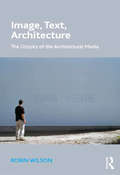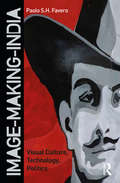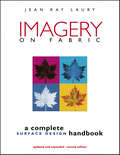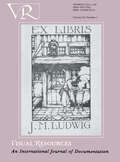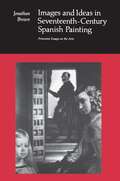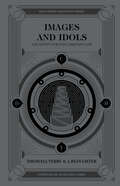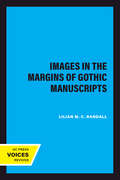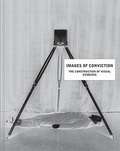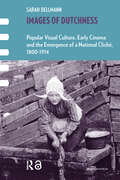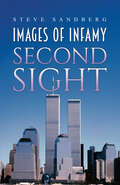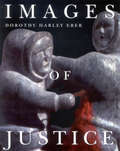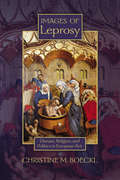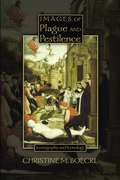- Table View
- List View
Image, Text, Architecture: The Utopics of the Architectural Media
by Robin WilsonImage, Text, Architecture brings a radical and detailed analysis of the modern and contemporary architectural media, addressing issues of architectural criticism, architectural photography and the role of journal editors. It covers examples as diverse as an article by British artist Paul Nash in The Architectural Review, 1940, an early project by French architects Lacaton & Vassal published in the journal 2G, 2001, and recent photography by Hisao Suzuki for the Spanish journal El Croquis. At the intersection of image and text the book also reveals the role of the utopian impulse within the architectural media, drawing on theories of utopian discourse from the work of the French semiotician and art theorist Louis Marin, and the American Marxist critic Fredric Jameson. Through this it builds a fresh theoretical approach to journal studies, revealing a hitherto unexplored dimension of "latent" or "unconscious" discourse within the media portrait of architecture. The purpose of this enquiry is to highlight moments where a different type of critical voice emerges on the architectural journal page, indicating the possibility of a more progressive engagement with the media as a platform for critical and speculative thinking about architecture, and to rethink the journals’ role within architectural history.
Image-Making-India: Visual Culture, Technology, Politics
by Paolo FaveroImage-Making-India explores the evolving meaning of images in a digital landscape from the vantage point of contemporary India. Building upon long-term ethnographic research among image-makers in Delhi, Mumbai and other Indian cities, the author interrogates the dialogue between visual culture, technology and changing notions of political participation. The book explores selected artistic experiences in documentary and fiction film, photography, contemporary art and digital curation that have in common a desire to engage with images as tools for social intervention. These experiences reveal images’ capacity not only to narrate and represent but also to perform, do and affect. Particular attention is devoted to the 'digital', a critical landscape that offers an opportunity to re-examine the significance of images and visual culture in a rapidly changing India. This volume will be of particular interest to scholars of visual and digital anthropology and cultures as well as South Asian studies.
Imagery On Fabric: A Complete Surface Design Handbook
by Jean Ray LauryThis completely revised edition is updated with the latest techniques for transferring images to fabric. Step-by-step instructions for today’s most exciting processes. Includes new full-color photos, complete material lists, and tips for safely accomplishing beautiful results. *Important Note about PRINT ON DEMAND Editions: This title will be printed after purchase and will arrive separately from any in-stock items. Please allow approximately 2 weeks for USA delivery, with an additional 2 weeks for international shipments. Expedited shipping is not available on POD Editions. The printing quality in this copy will vary from the original offset printing edition and may look more saturated due to printing on demand by a high-quality printer on uncoated (non-glossy) paper. The information presented in this version is the same as the most recent printed edition. Any pattern pullouts have been separated and presented as single pages.
Images Libraries Museums/Arch
by Amy MccollFirst Published in 1997. Routledge is an imprint of Taylor & Francis, an informa company.
Images and Ideas in Seventeenth-Century Spanish Painting (Princeton Essays on the Arts #1)
by Jonathan BrownArt historians have often minimized the variety and complexity of seventeenth-century Spanish painting by concentrating on individual artists and their works and by stressing discovery of new information rather than interpretation. As a consequence, the painter emerges in isolation from the forces that shaped his work. Jonathan Brown offers another approach to the subject by relating important Spanish Baroque paintings and painters to their cultural milieu.A critical survey of the historiography of seventeenth-century Spanish painting introduces this two-part collection of essays. Part One provides the most detailed study to date of the artistic-literary academy of Francisco Pacheco, and Part Two contains original studies of four major painters and their works: Las Meninas of Velázquez, Zurbarán's decoration of the sacristy at Guadalupe, and the work by Murillo and Valdés Leal for the Brotherhood of Charity, Seville. The essays are unified by the author's intention to show how the artists interacted with and responded to the prevailing social, theological, and historical currents of the time. While this contextual approach is not uncommon in the study of European art, it is newly applied here to restore some of the diversity and substance that Spanish Baroque painting originally possessed.
Images and Idols: Creativity for the Christian Life
by Thomas J Terry J. Ryan ListerChristians ought to be leading the way in creativity, but we rarely do. God is the Creator of all things, and He created us in His image. Creativity is woven into the very fabric of our humanity. Therefore, Christians should value and champion creativity as a vital part of our image-bearing role. Instead Christians often don&’t know what to do with creatives and creatives don&’t know what to do with Christianity. On one side you have Christians who neglect or discount art, imagination, and beauty altogether. On the other, you have artists who make idols out of each of these good things. Ryan Lister, a theology professor, and Thomas Terry, a spoken word artist and founder of Humble Beast, team up to help restore the connection between creativity and theology. Images & Idols is a theological and artistic exploration of creativity in the Christian life. It will help creatives build a strong theological foundation for their art, while challenging the church to embrace a theology of beauty and creativity.
Images and Idols: Creativity for the Christian Life
by Thomas J Terry J. Ryan ListerChristians ought to be leading the way in creativity, but we rarely do. God is the Creator of all things, and He created us in His image. Creativity is woven into the very fabric of our humanity. Therefore, Christians should value and champion creativity as a vital part of our image-bearing role. Instead Christians often don&’t know what to do with creatives and creatives don&’t know what to do with Christianity. On one side you have Christians who neglect or discount art, imagination, and beauty altogether. On the other, you have artists who make idols out of each of these good things. Ryan Lister, a theology professor, and Thomas Terry, a spoken word artist and founder of Humble Beast, team up to help restore the connection between creativity and theology. Images & Idols is a theological and artistic exploration of creativity in the Christian life. It will help creatives build a strong theological foundation for their art, while challenging the church to embrace a theology of beauty and creativity.
Images at War: Mexico from Columbus to Blade Runner (1492-2019)
by Serge Gruzinski"If colonial America was the melting pot of modernity, it was because it was also a fabulous laboratory of images. . . . Just as much as speech and writing, the image can be a vehicle for all sorts of power and resistance. " So writes Serge Gruzinski in the introduction to Images at War, his striking reinterpretation of the Spanish colonization of Mexico. Concentrating on the political meaning of the baroque image and its function within a multicultural society, Gruzinski compares its ubiquity in Mexico to our modern fascination with images and their meaning. Although the baroque image played a decisive role in many arenas, especially that of conquest and New World colonization, its powerful resonance in the sphere of religion is a focal point of Gruzinski's study. In his analysis of how images conveyed meaning across linguistic barriers, he uncovers recurring themes of false images, less-than-perfect replicas, the uprooting of peoples and cultural memories, and the violence of iconoclastic destruction. He shows how various ethnic groups--Indians, blacks, Europeans--left their distinct marks on images of colonialism and religion, coopting them into expressions of identity or instruments of rebellion. As Gruzinski's story unfolds, he tells of Aztec idols, the cult of the Virgin of Guadalupe, conquistadors, Franciscans, and neoclassical attempts to repress the baroque. In the final chapter he discusses the political and religious implications of contemporary imagery--such as that in Mexican soap operas--and speculates about the future of images in Latin America. Originally written in French, this work makes available to an English audience a seminal study of Mexico and the role of the image in the New World.
Images from the Region of the Pueblo Indians of North America
by Aby M. WarburgAby M. Warburg (1866–1929) is recognized not only as one of the century’s preeminent art and Renaissance historians but also as a founder of twentieth-century methods in iconology and cultural studies in general. Warburg’s 1923 lecture, first published in German in 1988 and now available in the first complete English translation, offers at once a window on his career, a formative statement of his cultural history of modernity, and a document in the ethnography of the American Southwest. This edition includes thirty-nine photographs, many of them originally presented as slides with the speech, and a rich interpretive essay by the translator.
Images from the Underworld: Naj Tunich and the Tradition of Maya Cave Painting
by Andrea J. StoneAn in-depth look at Maya cave painting from Preconquest times to the Colonial period, plus a complete visual catalog of the cave art of Naj Tunich.In 1979, a Kekchi Maya Indian accidentally discovered the entrance to Naj Tunich, a deep cave in the Maya Mountains of El Peten, Guatemala. One of the world&’s few deep caves that contain rock art, Naj Tunich features figural images and hieroglyphic inscriptions that have helped to revolutionize our understanding of ancient Maya art and ritual.In this book, Andrea Stone takes a comprehensive look at Maya cave painting from Preconquest times to the Colonial period. After surveying Mesoamerican cave and rock painting sites and discussing all twenty-five known painted caves in the Maya area, she focuses extensively on Naj Tunich. Her text analyzes the images and inscriptions, while photographs and line drawings provide a complete visual catalog of the cave art, some of which has been subsequently destroyed by vandals.This important new body of images and texts enlarges our understanding of the Maya view of sacred landscape and the role of caves in ritual. It will be important reading for all students of the Maya, as well as for others interested in cave art and in human relationships with the natural environment.&“Not only an extraordinarily detailed and insightful analysis of the painted representations and texts found in Naj Tunich but also a complete survey of all known Maya painted caves. . . . A major monograph on a major Maya site. For completeness of presentation, for clarity of writing, and for depth and scope of analysis, [Images from the Underworld] is a model of what a final report should be.&” —Journal of Anthropological Research
Images from the Underworld: Naj Tunich and the Tradition of Maya Cave Painting
by Andrea J. StoneAn in-depth look at Maya cave painting from Preconquest times to the Colonial period, plus a complete visual catalog of the cave art of Naj Tunich.In 1979, a Kekchi Maya Indian accidentally discovered the entrance to Naj Tunich, a deep cave in the Maya Mountains of El Peten, Guatemala. One of the world&’s few deep caves that contain rock art, Naj Tunich features figural images and hieroglyphic inscriptions that have helped to revolutionize our understanding of ancient Maya art and ritual.In this book, Andrea Stone takes a comprehensive look at Maya cave painting from Preconquest times to the Colonial period. After surveying Mesoamerican cave and rock painting sites and discussing all twenty-five known painted caves in the Maya area, she focuses extensively on Naj Tunich. Her text analyzes the images and inscriptions, while photographs and line drawings provide a complete visual catalog of the cave art, some of which has been subsequently destroyed by vandals.This important new body of images and texts enlarges our understanding of the Maya view of sacred landscape and the role of caves in ritual. It will be important reading for all students of the Maya, as well as for others interested in cave art and in human relationships with the natural environment.&“Not only an extraordinarily detailed and insightful analysis of the painted representations and texts found in Naj Tunich but also a complete survey of all known Maya painted caves. . . . A major monograph on a major Maya site. For completeness of presentation, for clarity of writing, and for depth and scope of analysis, [Images from the Underworld] is a model of what a final report should be.&” —Journal of Anthropological Research
Images in the Margins of Gothic Manuscripts (California Studies in the History of Art)
by Lilian M. RandallThis title is part of UC Press's Voices Revived program, which commemorates University of California Press’s mission to seek out and cultivate the brightest minds and give them voice, reach, and impact. Drawing on a backlist dating to 1893, Voices Revived makes high-quality, peer-reviewed scholarship accessible once again using print-on-demand technology. This title was originally published in 1966.This title is part of UC Press's Voices Revived program, which commemorates University of California Press’s mission to seek out and cultivate the brightest minds and give them voice, reach, and impact. Drawing on a backlist dating to 1893, Voices Revived</DIV
Images of Class: Operaismo, Autonomia and the Visual Arts (1962-1988)
by Jacopo GalimbertiThe first overview of the unique encounter between artists and the prominent Marxist current Workerism, also known as OperaismoDuring the 1960s and 1970s, Workerism and Autonomia were prominent Marxist currents. However, it is rarely acknowledged that these movements inspired many visual artists such as the members of Archizoom, Gordon Matta-Clark and Gianfranco Baruchello. This book focuses on the aesthetic and cultural discourse developed by three generations of militants (including Mario Tronti, Antonio Negri, Bifo and Silvia Federici), and how it was appropriated by artists, architects, graphic designers and architectural historians such as Manfredo Tafuri. Images of Classsignposts key moments of this dialogue, ranging from the drawings published on classe operaia to Potere Operaio&’s exhibition in Paris, the Metropolitan Indians&’ zines, a feminist art collective who adhered to the Wages for Housework Campaign, and the N group&’s experiments with Gestalt theory. Featuring more than 140 images of artworks, many published here for the first time, this volume provides an original perspective on post-war Italian culture and new insights into some of the most influential Marxist movements of the twentieth and twenty-first centuries worldwide.
Images of Conviction: The Construction of Visual Evidence
by Eric Stover Thomas Keenan Eyal Weizman Christian Delage Tomasz Kizny Luce Lebart Jennifer L. Mnookin Anthony PetiteauImages of Conviction shows, through 11 cases, how the photographic image is constructed to become evidence.
Images of Dutchness: Popular Visual Culture, Early Cinema and the Emergence of a National Cliché, 1800-1914 (Framing Film)
by Sarah DellmannWhy do early films present the Netherlands as a country full of canals and windmills, where people wear traditional costumes and wooden shoes, while industries and modern urban life are all but absent? Images of Dutchness investigates the roots of this visual repertoire from diverse sources, ranging from magazines to tourist brochures, from anthropological treatises to advertising trade cards, stereoscopic photographs, picture postcards, magic lantern slide sets and films of early cinema. This richly illustrated book provides an in-depth study of the fascinating corpus of popular visual media and their written comments that are studied for the first time. Through the combined analysis of words and images, the author identifies not only what has been considered Ÿtypically DutchŒ in the long nineteenth century, but also provides new insights into the logic and emergence of national clichés in the Western world.
Images of Infamy: Second Sight
by Steve SandbergTragic events can often be the catalyst and inspiration for the creation of meaningful works of art. In this case, it was the September 11th catastrophe of 2001 which provided the stimulus that would ultimately lead me down a totally unforeseen path, revealing an attitude never previously observed. Other than a proclivity for drawing geometric shapes, no artistic tendencies had even been evident.The one constant theme in my work is the recurring use of nines and elevens to generate images. Other symbols and characters are also employed; sometimes intentional, sometimes not. People who have explored my world have seen different things. Take the journey and see what you can uncover. Remember, in the future, be open to the feasibility that sometimes unexpected abilities can appear anytime in one&’s life. Be ready to embrace the opportunity these possibilities present and take them down your own personal road of discovery.
Images of Justice
by Dorothy Harley EberImages of Justice resonates with voices of the North and comes alive through interviews with many of those involved in the cases - defendants, judges, and prosecutors. Eber also provides valuable information on the little-known carvers who created these remarkable works of art. At a time when alternative legal systems for Native peoples are being debated, Images of Justice provides a lively, accessible account of the northern courts, their evolution, and their future in a changing northern society.
Images of Justice: A Legal History Of The Northwest Territories And Nunavut As Traced Through The Yellowknife Courthouse Collection Of Inuit Sculpture (McGill-Queen's Indigenous and Northern Studies #154)
by Dorothy Harley EberImages of Justice resonates with voices of the North and comes alive through interviews with many of those involved in the cases - defendants, judges, and prosecutors. Eber also provides valuable information on the little-known carvers who created these remarkable works of art. At a time when alternative legal systems for Native peoples are being debated, Images of Justice provides a lively, accessible account of the northern courts, their evolution, and their future in a changing northern society.
Images of Leprosy: Disease, Religion, and Politics in European Art (Early Modern Studies #7)
by Christine M. BoecklFrom biblical times to the onset of the Black Death in the fourteenth century, leprosy was considered the worst human affliction, both medically and socially. Only fifty years ago, leprosy, or Hansen’s disease, was an incurable infectious illness, and it still remains a grave global concern. Recently, leprosy has generated attention in scholarly fields from medical science to the visual arts. This interdisciplinary art-historical survey on lepra and its visualization in sculpture, murals, stained glass, and other media provides new information on the history of art, medicine, religion, and European society. Christine M. Boeckl maintains that the various terrifying aspects of the disease dominated the visual narratives of historic and legendary figures stricken with leprosy. For rulers, beggars, saints, and sinners, the metaphor of leprosy becomes the background against which their captivating stories are projected.
Images of Leprosy: Disease, Religion, and Politics in European Art (Early Modern Studies #Vol. 7)
by Christine M. BoecklFrom biblical times to the onset of the Black Death in the fourteenth century, leprosy was considered the worst human affliction, both medically and socially. Only fifty years ago, leprosy, or Hansen’s disease, was an incurable infectious illness, and it still remains a grave global concern. Recently, leprosy has generated attention in scholarly fields from medical science to the visual arts. This interdisciplinary art-historical survey on lepra and its visualization in sculpture, murals, stained glass, and other media provides new information on the history of art, medicine, religion, and European society. Christine M. Boeckl maintains that the various terrifying aspects of the disease dominated the visual narratives of historic and legendary figures stricken with leprosy. For rulers, beggars, saints, and sinners, the metaphor of leprosy becomes the background against which their captivating stories are projected.
Images of Lust: Sexual Carvings on Medieval Churches
by James Jerman Anthony WeirSexually explicit sculptures may be found on a number of medieval churches in France and Spain. This fascinating study examines the origins and purposes of these sculptures, viewing them not as magical fertility symbols, nor even as idols of ancient pre-Christian religions, but as serious works that dealt with the sexual customs and salvation of medieval folk, and thus gave support to the Church's moral teachings.
Images of Occupation in Dutch Film: Memory, Myth, and the Cultural Legacy of War (Framing Film)
by Wendy BurkeThe German occupation of the Netherlands during World War II left a lasting mark on Dutch memory and culture. This book is the first to explore depictions of that period in films made a generation later, between 1962 and 1986. As Dutch public opinion towards the war altered over the postwar decades, the historical trajectory of Dutch recovery and reconstruction-political, economic, and, most complicated of all, psychological-came to be revealed, often unconsciously, in the films of the period.
Images of Plague and Pestilence: Iconography and Iconology (Sixteenth Century Essays & Studies #53)
by Christine M. BoecklSince the late fourteenth century, European artists created an extensive body of images, in paintings, prints, drawings, sculptures, and other media, about the horrors of disease and death, as well as hope and salvation. This interdisciplinary study on disease in metaphysical context is the first general overview of plague art written from an art-historical standpoint. The book selects masterpieces created by Raphael, Titian, Tintoretto, Rubens, Van Dyck, and Poussin, and includes minor works dating from the fourteenth to twentieth centuries. It highlights the most important innovative artistic works that originated during the Renaissance and the Catholic Reformation. This study of the changing iconographic patterns and their iconological interpretations opens a window to the past.
Images of Plague and Pestilence: Iconography and Iconology (Sixteenth Century Essays & Studies #53)
by Christine M. BoecklSince the late fourteenth century, European artists created an extensive body of images, in paintings, prints, drawings, sculptures, and other media, about the horrors of disease and death, as well as hope and salvation. This interdisciplinary study on disease in metaphysical context is the first general overview of plague art written from an art-historical standpoint. The book selects masterpieces created by Raphael, Titian, Tintoretto, Rubens, Van Dyck, and Poussin, and includes minor works dating from the fourteenth to twentieth centuries. It highlights the most important innovative artistic works that originated during the Renaissance and the Catholic Reformation. This study of the changing iconographic patterns and their iconological interpretations opens a window to the past.
Images of the Byzantine World: Visions, Messages and Meanings: Studies presented to Leslie Brubaker
by Angeliki LymberopoulouThe main themes of this volume are the identification of 'visions', 'messages', and 'meanings' in various facets of Byzantine culture and the possible differences in the perception of these visions, messages and meanings as seen by their original audience and by modern scholars. The volume addresses the methodological question of how far interpretations should go - whether there is a tendency to read too much into too little or whether not enough attention is paid to apparent minutiae that may have been important in their historical context. As the essays span a wide chronological era, they also present a means of assessing the relative degrees of continuity and change in Byzantine visions, messages and meanings over time. Thus, as highlighted in the concluding section, the book discusses the validity of existing notions regarding the fluidity of Byzantine culture: when continuity was a matter of a rigid adherence to traditional values and when a manifestation of the ability to adapt old conventions to new circumstances, and it shows that in some respects, Byzantine cultural history may have been less fragmented than is usually assumed. Similarly, by reflecting not just on new interpretations, but also on the process of interpreting itself, the contributors demonstrate how research within Byzantine studies has evolved over the past thirty years from a set of narrowly defined individual disciplines into a broader exploration of interconnected cultural phenomena.
